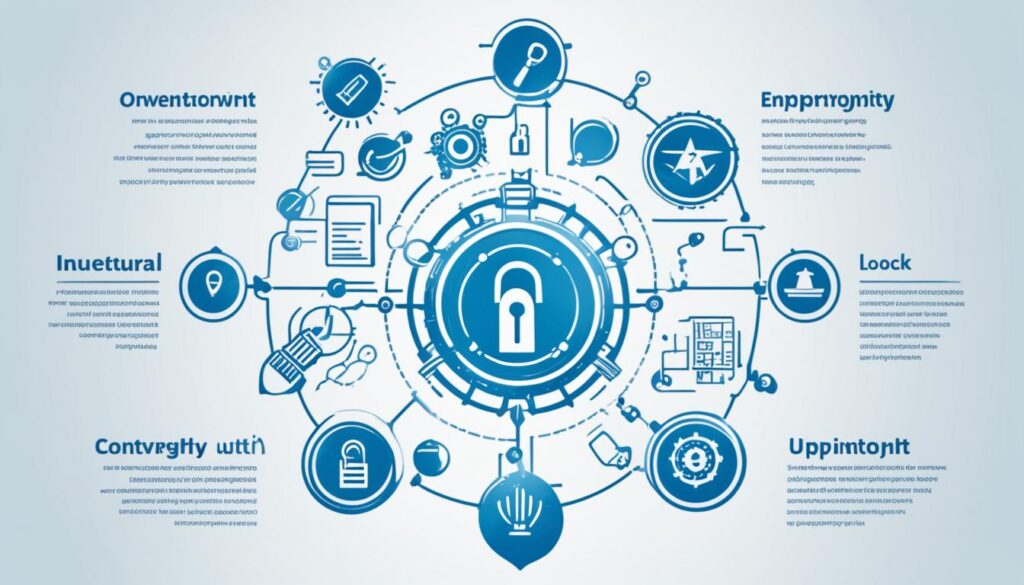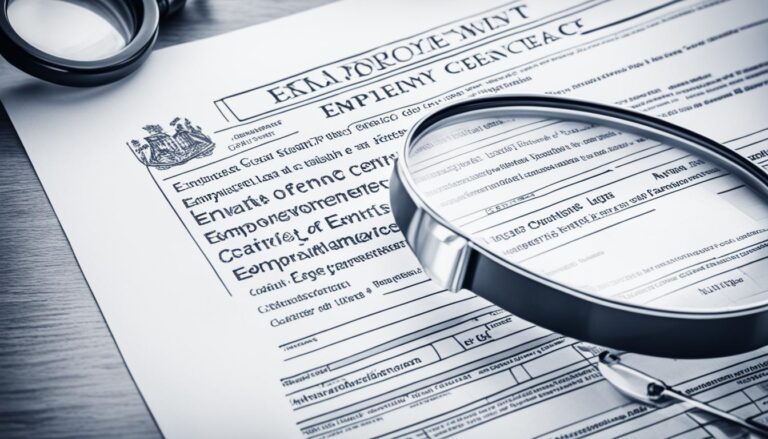Intellectual Property Rights in Employment FAQs
Greetings! Welcome to our informative guide on Intellectual Property (IP) rights in employment. In today’s fast-paced world, where innovation and creativity drive businesses, understanding IP rights is essential for both employees and employers. Here, we will explore the key aspects of IP rights in the workplace, providing clarity and insight into this complex area.
Intellectual property encompasses a broad range of creations, inventions, and designs that deserve protection. From copyrights and patents to trademarks and designs, these rights can be owned by individuals and businesses alike. As an employee, it’s crucial to be aware of the rights pertaining to your work, while employers must understand their obligations in safeguarding their intellectual property.
Throughout this guide, we will address frequently asked questions and provide expert insights on various topics, such as copyright in employment, patent rights in employment, protecting IP in the workplace, and more. So, let’s dive in and gain a comprehensive understanding of intellectual property rights in the employment context.
Key Takeaways:
- Understanding IP rights in employment is crucial for both employees and employers.
- Intellectual property encompasses creations, inventions, and designs that deserve protection.
- Different types of IP rights include copyrights, patents, trademarks, and designs.
- Owning and protecting IP in the workplace requires clear agreements and contracts.
- Employees and employers should be aware of their rights and obligations regarding IP.
What is Intellectual Property?
Intellectual property encompasses a wide array of intangible assets that originate from the creative and imaginative power of the human mind. It encompasses various creations, inventions, designs, and trademarks that can be protected under intellectual property laws. These legal protections safeguard the rights of creators and innovators, ensuring that their intellectual property is not unlawfully used, copied, or stolen by others.
At its core, intellectual property consists of four main categories: copyright, patents, designs, and trademarks. Each category serves a distinct purpose in safeguarding different types of intellectual property:
- Copyright: Copyright protection is granted to original works of authorship, such as literary and artistic expressions, music, films, and computer software. It gives creators the exclusive right to reproduce, distribute, and publicly display their works.
- Patents: Patents protect inventions and technical innovations, granting inventors exclusive rights to their creations. This protection allows inventors to prevent others from making, using, or selling their patented inventions for a limited period.
- Designs: Designs protect the visual appearance of products, including their shape, configuration, pattern, or ornamentation. Design protection ensures that the unique aesthetic features of a product are safeguarded from being copied or imitated by others.
- Trademarks: Trademarks safeguard brand names, logos, and other distinctive signs that identify and differentiate products or services in the marketplace. Trademark protection helps prevent confusion among consumers and enables businesses to establish and maintain their brand identity.
By providing legal frameworks and mechanisms, intellectual property laws encourage innovation, creativity, and economic growth. They incentivize individuals, businesses, and organizations to invest time, resources, and effort in developing groundbreaking solutions, artistic works, and distinctive brands.
Intellectual property is the cornerstone of our modern society, rewarding and protecting the ingenuity and creativity that fuel progress and shape our world.
In the next section, we will explore the ownership of intellectual property and the factors that determine who holds the rights to these valuable assets.
Ownership of Intellectual Property
In the world of intellectual property, ownership is a critical aspect that determines the rights and control over creations and innovations. Understanding who owns intellectual property is crucial for creators, businesses, and individuals alike. In this section, we will explore the factors that determine ownership and the various ways in which ownership can be acquired.
Creators’ Rights
As a general rule, the creator of intellectual property is the rightful owner of their creation. Whether it is an invention, design, or artistic work, the person who brings it into existence holds the initial ownership rights. This principle ensures that creators have control and recognition for their contributions.
For example, if an author writes a book, they hold the copyright to it. Likewise, if an individual invents a new technology, they are the initial owner of the patent rights. This ownership empowers creators to protect and profit from their intellectual endeavors.
Buying Intellectual Property Rights
Ownership of intellectual property can also be acquired through the purchase of rights. In some cases, creators may choose to sell or transfer their ownership to another party. This can be done through contracts, agreements, or licensing arrangements.
Acquiring intellectual property rights through purchase can be an effective strategy for businesses looking to expand their portfolios or individuals seeking to develop a brand. By buying existing intellectual property rights, they can access established brands, inventions, or creative works, saving time and effort in creating something from scratch.
Trade Marks and Ownership
In certain instances, ownership can also be established through the creation and ownership of a well-known product or brand. Registering a trade mark gives the owner exclusive rights to use and protect that mark, effectively establishing ownership over their brand identity.
“Registering our trade mark not only safeguarded our brand, but it also solidified our ownership over our unique offering in the market,” says David Smith, CEO of Smith Industries.
Having a trade mark can provide legal protection against unauthorized use of the brand name, logo, or other identifiers. It also grants the owner the ability to license or sell the trade mark, allowing others to utilize the brand in return for royalties or fees.
Establishing Ownership Rights
To avoid disputes or confusion regarding ownership of intellectual property, it is crucial to establish ownership rights through agreements and contracts. Clear documentation that outlines ownership, transfer of rights, or licensing arrangements can help prevent any future legal issues.
For example, when a business collaborates with a freelancer to develop a new product, there should be a written agreement specifying the ownership of the intellectual property. This ensures that both parties understand their rights and obligations, mitigating any disputes that may arise in the future.

By clarifying ownership through agreements, creators, businesses, and individuals can protect their intellectual property and ensure that they are rightfully recognized and rewarded for their innovations and creations.
Intellectual Property Rights for Self-Employed Individuals
If you are self-employed, you have the advantage of retaining ownership rights to the intellectual property you create. This means that any innovative ideas, inventions, or creative works you develop as a self-employed individual belong to you, by default. However, it is important to note that this ownership can be influenced by specific circumstances, such as agreements or contracts you enter into.
In the world of intellectual property, ownership is often determined by the terms outlined in an employment contract or agreement. If you create intellectual property while working on a project for a client or as part of a commercial engagement, the ownership rights may be subject to the terms established in the employment contract with that particular client or employer.
This brings us to the significance of reviewing your employment contracts and agreements thoroughly. Understanding the provisions related to intellectual property ownership is crucial for self-employed individuals who engage in work where ownership rights may be shared or transferred to the client or employer.
By carefully examining the language and clauses in your employment contracts or agreements, you can ascertain whether there are any provisions that define intellectual property ownership rights and if these rights are retained by the client or employer. Pay particular attention to sections that discuss ownership, assignment, or transfer of intellectual property rights.
Additionally, seek legal advice or consult with an intellectual property professional to ensure you fully comprehend the implications and consequences of these contractual terms. They can guide you through the legal complexities and help safeguard your intellectual property rights as a self-employed individual.
Protecting your intellectual property is crucial for maintaining your competitive advantage and preserving the value of your creations. Understanding your ownership rights and conducting due diligence by reviewing your employment contracts are essential steps to protect your valuable intellectual property as a self-employed professional.
Determining Intellectual Property Ownership in Employment Contracts
- Review your employment contracts and agreements to understand the provisions related to intellectual property ownership.
- Pay close attention to clauses that discuss ownership, assignment, or transfer of intellectual property rights.
- Consult with an intellectual property professional or seek legal advice to ensure you fully comprehend the implications of these contractual terms.
- Take steps to protect your intellectual property, such as registering trademarks, copyrighting your works, or applying for patents if applicable.
By taking these proactive measures, you can ensure that your intellectual property remains protected and that you retain the ownership rights you deserve as a self-employed individual.

The Types of Intellectual Property Protection
When it comes to safeguarding intellectual property, there are various types of protection available. Understanding these types can help individuals and businesses protect their creations and innovations effectively.
Copyright
Copyright is a form of intellectual property protection that applies to creative works such as books, music, and artwork. It grants the creator exclusive rights to reproduce, distribute, and display their work, preventing others from using it without permission. Copyright protection is automatic, meaning that once a work is created, it is protected by copyright law.
Patents
Patents are designed to protect inventions and technical innovations. They grant the inventor exclusive rights to their invention for a specified period, typically 20 years. Patents prevent others from making, using, or selling the patented invention without permission. To obtain a patent, an inventor must file a patent application, demonstrating that their invention is novel, non-obvious, and useful.
Designs
Designs refer to the visual appearance of products, including their shape, configuration, and ornamentation. Design protection prevents others from copying or reproducing a product’s unique aesthetic features. This type of intellectual property protection is particularly relevant to industries such as fashion, furniture, and industrial design. Design registration is typically obtained by filing an application with the relevant intellectual property office.
Trademarks
Trademarks are used to protect brand names, logos, and other identifiers that distinguish goods and services from others in the marketplace. Trademarks ensure that consumers can identify and differentiate between products and services, fostering competition and consumer trust. Obtaining trademark protection involves registering the mark with the appropriate intellectual property office, demonstrating its distinctiveness and non-generic nature.
To summarize, copyright, patents, designs, and trademarks are different types of intellectual property protection available. Copyright safeguards creative works, patents protect inventions, designs protect a product’s visual appearance, and trademarks protect brand identifiers. Understanding these types of protection and their requirements allows individuals and businesses to effectively safeguard their intellectual property.

Intellectual Property Rights in Employment Agreements
When it comes to intellectual property rights in the employment context, it is essential to have clear agreements in place to protect the interests of both the employer and the employee. Two key elements of these agreements are the assignment of inventions and ownership of discoveries.
The assignment of inventions agreement outlines that any intellectual property created by an employee during the course of their employment will belong to the employer. This agreement ensures that the employer has the exclusive rights and ownership of the inventions and innovations developed by their employees.
Similarly, the ownership of discoveries agreement establishes that the employer will own any valuable discoveries made by the employee during their employment. This includes any significant findings or breakthroughs that contribute to the employer’s intellectual property portfolio.
Having these agreements in place is crucial for protecting the employer’s IP rights and preventing any disputes or confusion regarding ownership. It ensures that the employer can fully exploit and benefit from the intellectual property developed within their organization.
Moreover, it is important to note that these agreements typically require consideration to support their validity. Consideration refers to the exchange of something of value between the employer and the employee, such as a bonus, stock options, or other forms of compensation. This exchange ensures that both parties have legally binding obligations and that the agreement is enforceable.
“By clearly defining the ownership of intellectual property in employment agreements, employers can safeguard their valuable creations and innovations, while employees can understand their rights and obligations within the workplace.”
In the example below, we can see a simplified table illustrating the main points of an assignment of inventions agreement:
| Key Elements of Assignment of Inventions Agreement | |
|---|---|
| Scope | Specifies the types of inventions covered by the agreement, whether they are related to the employee’s job duties or any inventions created during employment. |
| Ownership | Clearly defines that all intellectual property rights in the inventions belong to the employer, regardless of the employee’s involvement or contribution. |
| Disclosure | Requires the employee to promptly disclose any inventions they develop during their employment. |
| Cooperation | Mandates that the employee cooperates fully in obtaining and maintaining necessary patents or registrations for the inventions. |
| Non-Competition | Includes provisions restricting the employee’s ability to compete with the employer using the inventions or intellectual property developed. |

Protecting Intellectual Property in the Workplace
At our workplace, we understand the importance of protecting intellectual property. As an employer, there are several measures we can take to safeguard our valuable assets and prevent unauthorized access or disclosure. Let’s explore some effective strategies:
Implementing Trade Secrets
Trade secrets play a crucial role in safeguarding proprietary information and processes. By identifying and classifying sensitive data as trade secrets, we can enforce legal protections and maintain a competitive advantage. These may include customer lists, marketing strategies, product formulas, or manufacturing processes.
“Trade secrets give us a unique edge in the market by keeping our valuable information confidential and out of our competitors’ hands.”
Confidentiality Agreements
Requiring employees to sign confidentiality agreements is another effective way to protect intellectual property. These agreements outline the responsibilities and obligations of employees to keep sensitive information confidential, even after their employment ends. Confidentiality agreements set clear expectations and provide legal recourse in case of breaches.
Educating Employees
Educating our employees about the importance of intellectual property protection is crucial to fostering a culture of awareness and responsibility. By educating them about trade secrets, copyrights, patents, and trademarks, we empower our workforce to recognize and protect intellectual property. Regular training sessions and awareness campaigns reinforce the significance of maintaining confidentiality and respecting our intellectual assets.
Implementing Security Measures
Implementing robust security measures is essential to prevent unauthorized access or theft of intellectual property. This may involve physical security measures such as restricted access areas, as well as digital safeguards like firewalls, encryption, and secure document management systems. By implementing these measures, we ensure that our intellectual property remains secure and protected.
Protecting intellectual property in the workplace is not only crucial for our business’s success but also for maintaining our competitive edge in the market. By implementing trade secrets, confidentiality agreements, and educating our employees, we create a culture of intellectual property protection. Combining these efforts with robust security measures, we can confidently safeguard our valuable assets for the long term.
Intellectual Property Infringement and Legal Remedies
Intellectual property infringement is a serious violation that occurs when someone uses, copies, or reproduces someone else’s intellectual property without obtaining proper permission. This can include copyright infringement, patent infringement, or other forms of IP infringement. It is crucial for intellectual property owners to be aware of their rights and take appropriate legal action to protect their valuable creations.
In cases of IP infringement, there are legal remedies available to the owners of the infringed intellectual property. These remedies aim to compensate the owners for the damages caused by the infringement and to prevent further unauthorized use of their work. Some of the common legal remedies for intellectual property infringement include:
- Monetary Damages: The owner of the infringed intellectual property may seek monetary compensation for the losses suffered as a result of the infringement. This can include both actual damages (such as lost profits) and statutory damages (established by law).
- Injunctions: The owner can request a court to issue an injunction to stop the infringer from further using or distributing the intellectual property. This can help prevent additional harm to the owner’s rights.
- Attorney’s Fees and Costs: The owner may also be entitled to recover attorney’s fees and costs associated with pursuing legal action against the infringer. This can help alleviate the financial burden of enforcing their rights.
Enforcing intellectual property rights through legal action is essential to maintain the integrity and value of the creations. It sends a clear message that IP infringement will not be tolerated, protecting not only the rights of the owner but also promoting innovation and creativity in society.
“Intellectual property infringement can have significant consequences. It is important for creators to take necessary legal measures to protect their work and seek appropriate remedies when infringement occurs.”
By enforcing their rights and seeking legal remedies, intellectual property owners can deter future infringements and safeguard the fruits of their creative labor. It is crucial to consult with legal professionals specializing in intellectual property law to navigate the complex legal landscape and achieve the best possible outcome in cases of infringement.
Intellectual Property Rights for Independent Contractors
When engaging independent contractors, it is crucial to establish clear intellectual property rights through an independent contractor agreement. This legally binding document ensures that any intellectual property created by the contractor belongs exclusively to the company. By clearly defining ownership in the agreement, you can eliminate potential disputes and protect the company’s valuable assets.
An independent contractor agreement should include specific provisions for the transfer of ownership rights. This ensures that the company retains full control and ownership of the intellectual property created by the contractor. It is essential to consult with legal professionals to draft a comprehensive agreement that covers all necessary aspects of intellectual property ownership.
By securing ownership rights in an independent contractor agreement, your company can safeguard its intellectual property and prevent unauthorized use or distribution. This not only protects your competitive advantage but also allows you to fully exploit and commercialize the intellectual property for business growth.
The Importance of Independent Contractor Agreements
“The independent contractor agreement is a crucial tool for establishing ownership of intellectual property. By clearly defining ownership rights, companies can protect their valuable assets and avoid any ambiguity or legal disputes.”
Independent contractor agreements serve as a cornerstone in defining the relationship between the company and the contractor. By clearly stipulating ownership rights, these agreements provide a legal framework that protects both parties’ interests.
Through an independent contractor agreement, you can:
- Establish ownership of intellectual property: By explicitly stating that the company owns all intellectual property created by the contractor, you ensure that the rights belong exclusively to your business.
- Protect trade secrets and confidential information: Confidentiality clauses in the agreement help safeguard sensitive company information, preventing the contractor from divulging it to competitors or unauthorized parties.
- Clarify rights and obligations: The agreement sets clear expectations regarding the contractor’s responsibilities and the company’s rights in relation to intellectual property.
Securing Intellectual Property Rights: A Case Study
Let’s take a look at a real-life case study that demonstrates the importance of securing intellectual property rights through an independent contractor agreement:
| Case Study: Protecting Intellectual Property |
|---|
|
A technology start-up, TechCo, hired an independent contractor, Sam, to develop a custom software solution. TechCo recognized the importance of protecting its intellectual property and included a comprehensive independent contractor agreement in their engagement. The agreement clearly stated that all intellectual property created by Sam during the project would belong exclusively to TechCo. It also included a non-disclosure clause, ensuring that Sam would not share any confidential information with third parties. Thanks to the agreement, TechCo was able to successfully launch the software solution with full ownership and control over the intellectual property. This provided TechCo with a competitive advantage and the ability to license the software to other companies, generating additional revenue. |
In the example above, the independent contractor agreement played a pivotal role in securing TechCo’s intellectual property rights. By explicitly stating ownership and confidentiality provisions, TechCo protected its valuable assets and harnessed the full potential of the developed software.
As demonstrated by this case study, an independent contractor agreement is an essential tool for protecting intellectual property. By including the appropriate clauses and provisions, businesses can ensure that their intellectual property remains secure and an asset to drive their success.
Next, in Section 10, we will explore the ownership of independent inventions and how it can be influenced by the employment relationship.
Intellectual Property Ownership and Independent Inventions
When it comes to intellectual property ownership, it’s important to consider whether the creation was developed within the course of employment or outside of the employment relationship.
If an employee was specifically hired to create a particular intellectual property as part of their job, the ownership generally belongs to the employer. This means that the employer has the rights to the creation and can control its use and distribution.
However, if the idea was conceived or developed outside of the employment relationship, the employee may retain ownership rights. In such cases, the employee has the freedom to use and sell their intellectual property independently without the involvement or control of the employer.
The determination of ownership is influenced by several factors, including the nature of the position and the directives given by the employer. For example, if an employee is hired as an inventor and is specifically instructed to create new inventions for the company, the employer will likely have ownership rights over those inventions.
It is important for both employers and employees to understand these ownership principles and establish clear agreements to avoid any disputes or confusion. By defining ownership rights in employment contracts or intellectual property agreements, parties can safeguard their interests and ensure compliance with intellectual property laws.
In the next section, we will explore the importance of confidentiality agreements in protecting intellectual property in the workplace.
Conclusion
Understanding intellectual property rights in employment is crucial for both employers and employees. By establishing written agreements, employers can ensure ownership of the intellectual property created by employees during their employment. It’s important for employees to be aware of their rights and obligations related to intellectual property in the workplace.
Protecting intellectual property is essential as it fosters innovation, creativity, and the growth of businesses. Employers should implement measures to safeguard their intellectual property, such as using trade secrets and requiring confidentiality agreements. Educating employees about the significance of protecting intellectual property and implementing security measures is also vital to prevent unauthorized access or disclosure.
In summary, intellectual property rights in employment play a significant role in the modern workplace. By having clear agreements and understanding these rights, both employers and employees can navigate the complexities of intellectual property with confidence, fostering a culture of innovation and driving business success.
FAQ
What is intellectual property?
Intellectual property refers to the protection of various creations, inventions, and designs. It includes copyright, patents, designs, and trademarks.
Who owns intellectual property?
In general, the creator of intellectual property owns the rights to it. Ownership can also be acquired through purchase or through owning a well-known product or brand.
Who owns intellectual property created by an employee?
If an employee creates intellectual property within the course of their employment, the ownership rights generally belong to the employer.
What types of intellectual property protection are there?
There are various types of intellectual property protection, including copyright, patents, designs, and trademarks.
How can intellectual property rights be established in employment agreements?
Intellectual property rights in employment agreements can be established through an assignment of inventions or ownership of discoveries agreement.
How can employers protect intellectual property in the workplace?
Employers can protect intellectual property by implementing trade secrets, requiring employees to sign confidentiality agreements, and implementing security measures to prevent unauthorized access or disclosure.
What can be done if someone infringes on intellectual property rights?
The owner of the intellectual property can seek legal remedies, including monetary damages, injunctions to stop the infringement, or seeking attorney’s fees and costs.
How can intellectual property rights be established for independent contractors?
Intellectual property rights for independent contractors can be established through an independent contractor agreement that specifies the ownership of intellectual property created.
How does ownership of intellectual property work for independent inventions?
Ownership of intellectual property can be affected by whether the creation was developed within the course of employment. Factors such as the nature of the position and the directives given by the employer can determine ownership.






